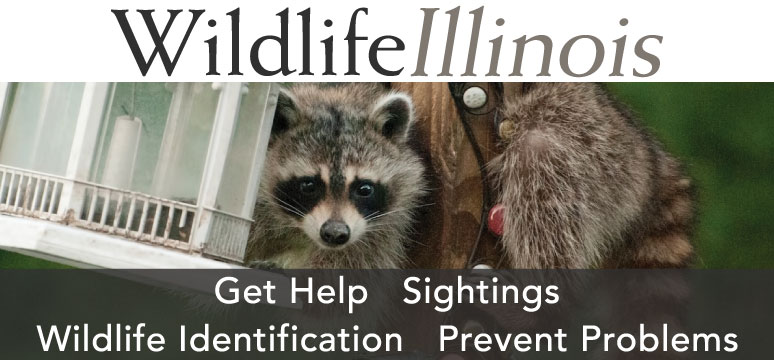
A dry pond provided three human visitors the opportunity to explore the habits and habitats of visiting mammals.



A dry pond provided three human visitors the opportunity to explore the habits and habitats of visiting mammals.
Photos by the author.
Something was amiss on a late summer visit to Matthiessen State Park in LaSalle County. A pond that usually held water was dry. Scrambling down the bank, my companions and I decided to employ our detective skills and see what we could learn.

Curious shallow channels crossed the center of the former water body. Holes located within the banks of the shallow, now exposed, channels told of a small aquatic mammal’s use of the pond. The channels—technically known as muskrat runs—once were underwater trails leading to den entrances that had been dug by muskrats. The runs revealed the paths these common wetland inhabitants traveled from their dens to now-absent feeding platforms.
The pond was just beginning to reveal its story. As the runs merged and became larger, we realized that beavers had also inhabited the pond. The runs continued toward the former shoreline where a large, conically shaped earthen mound was barely discernable behind a screen of brushy vegetation. Two openings, sufficient in diameter for a rotund animal, were visible beneath the mound. Those once underwater entrances and the lodge were evidence that this pond had once hosted another semi-aquatic rodent species, ‘nature’s engineer,’ the beaver.
Deeper sections within the muskrat runs held shallow pools of water in the waning days of summer. A few small minnows remained in the murky water as the oxygen level reached a level too low to support much life. Young-of-the-year frogs sprang from the mud in a frenzy of energy. Crayfish had left their signature muddy chimneys along the former shoreline. While not as abundant as when the pond held water, enough food remained to attract wildlife.
And attract wildlife it did. The muskrat runs were cluttered with tracks waiting for forensic analysis. Paired, flat-footed tracks showing claws on each of the five toes revealed that a usual mammalian suspect, the raccoon, had been present. An omnivore, the raccoon likely visited the pond in search of crayfish, fish and frogs to supplement their diet of nuts, fruits, berries and grasses.
A series of tracks less than 2 inches in length and width were sighted. Showing only four toes on the front and rear tracks, they were left by one of top predators in Illinois’ aquatic food web, the American mink. A resident of aquatic habitats, the mink is known to utilize muskrat dens.
With webbing and claw marks visible on approximately 2½ to 3½ inch-wide tracks, great delight was expressed when it was confirmed a river otter was in the area. Less than 100 river otters remained in Illinois by the late 1980s. In the mid-1990s, Illinois Department of Natural Resources biologists released 346 river otters from Louisiana in southeastern and central Illinois. That reintroduction program has resulted in today’s growing population and made the river otter one of Illinois’ modern-day wildlife success stories.
The distinct, heart-shaped, two-toed tracks of the white-tailed deer revealed that Illinois’ state animal frequented the site, likely pausing for a drink. Water is a survival necessity for deer and other wildlife, especially during the hotter months of the year.
Evidence also existed that large predators had passed through in search of a meal. With some experience, the tracks of a coyote can be distinguished from those of a medium-sized dog because they are typically more oval-shaped. Looking at the big picture, the travel route of a coyote will be a straight-line rather than the wandering track left by a dog. Coyote prints may be up to 3 inches in length and the nail prints will be visible.
Close examination of the tracks revealed yet one more mammal had passed through the muddy pond bed. At approximately 2 inches in length, the tracks left by a bobcat were smaller than those left by the coyote. The round tracks did not show claw marks, a key identification clue for members of the cat family.

Nature takes its course after any animal feeds a fecal deposit will be left. Visual forensics—size, shape and contents of the scat—came into play in our attempt to discern what species had left a calling card. The likely suspects had already been noted by the muddy tracks.
Pausing from our focus on the ground beneath our feet, we watched a cedar waxwing dart from its once water-logged tree perch to pluck insects from the sky. On a low branch in a shady cove, a green heron stood, head cocked as it watched for potential prey in a shallow pool.
Ever curious, a little post-trip detective work was needed to determine why the pond had dried up. Located in an old mine site, a sink hole had apparently developed, with the water draining into the abandoned mine. The chapter of the life of the pond had closed. Revisiting the site in the future most likely will tell a new tale, one of succession.
Natural history stories taking place underwater, and in the case of many mammals under the cover of darkness, often go unwitnessed. When an unexpected opportunity presents itself, take the time to celebrate the moment and examine the inner-workings of a wildlife-rich transitional aquatic habitat.
Kathy Andrews Wright retired from the Illinois Department of Natural Resources where she was editor of OutdoorIllinois magazine. She is currently the editor of OutdoorIllinois Journal.
Submit a question for the author